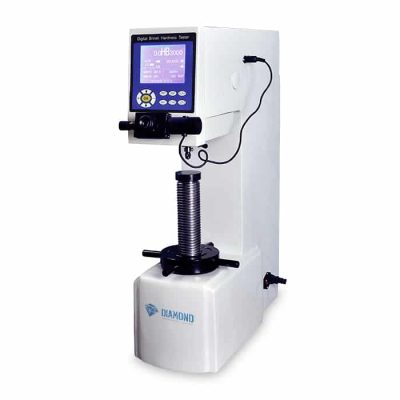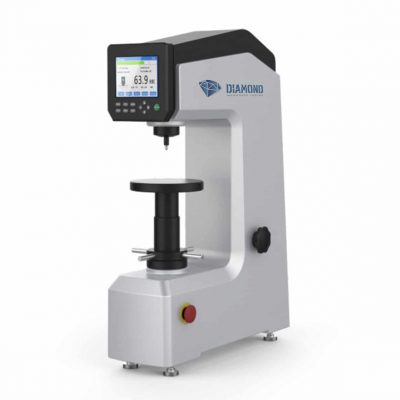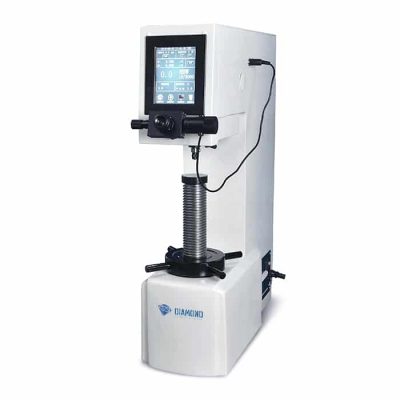Home > Steel Hardness Tester
Steel Hardness Tester
Products
All materials have different hardness values or their ability to resist deformation due to applied load or force. However, assessing this hardness is done in several ways depending on the material, its size, and the level of accuracy required. Hence, to evaluate the hardness of steel, a measuring tool known as a steel hardness tester is often used to assess its ability to resist failure or to bend due to some applied load or force. Steel hardness testers often come in different shapes and sizes. Still, they all measure the same parameters using popular hardness testing methods like Rockwell, Brinell, Vickers, and Leeb. Steel is known to have good tensile strength and can resist bending due to its elasticity. These properties are often harnessed to reinforce other materials like concrete that are low in tensile strength.
Steel Hardness Tester
-

Macro Vickers Hardness Tester SVH05
$50.00 Add to cart -

Electronic Brinell Hardness Tester DBH06
$50.00 Add to cart -

Digital Vickers Hardness Tester TVH08
$50.00 Add to cart -

Digital Rockwell Hardness Tester TRH06
$50.00 Add to cart -

Digital Brinell Hardness Tester TBH07
$50.00 Add to cart -

Automatic Rockwell Hardness Tester DRH08
$50.00 Add to cart
Why Global Clients Choose Us?
25 Years of Expertise
We have 25 years of experience in the professional production of hardness testing devices, an annual output of more than 10,000 hardness testers.
Talented Engineers and support team
As of September 2020, we have a total of 125 employees, including nearly 35 professional and technical workers who are masters or doctorate degree holders.
Advanced production equipment
We have Complete machining workshop, CNC, CNC machine tools, and more than 50 other types of processing equipment,to ensure high-precision product parts.
Excellent After-Sales Service
We provided excellent after-sales service, including fast delivery, online training, immediate feedback of trouble shotting.
Questions on Steel Hardness Tester
1. How do you Test the Hardness of Steel?
Steel often undergoes different standard tests to ascertain its hardness, which determines its strength. This strength is often used in design to verify its suitability for reinforcing certain structural elements, like in the case of concrete structures. The principal activity that underscores steel hardness testing is using an indenter of a specific size impacting the steel material’s surface with a known load over a set time. The impact of this load often causes an indentation that is measured and used in calculating the hardness value of steel.
2. What is the Common Test used to Measure the Hardness of Steel?
Here are the most common industry accepted methods for measuring the hardness of steel, often depending on the steel’s size, thickness, and level of accuracy of the result expected.
Brinell Hardness Test
In the Brinell hardness testing method, the steel material is subjected to the impact of an indenter made from a carbide ball or hardened steel of 10mm diameter. A 3,000kg load is often used to impact very hard materials with smaller loads of 500 to 1,500kg for softer materials. Also, the carbide ball is often used for very thick materials. The load is held for 15 seconds for steel and 30 seconds for some other metals. A measurement of the indentation left on the steel material using an optical instrument like the microscope is taken to calculate the hardness value of the steel material.
Vickers Hardness Test
The indenter in Vickers hardness testing method is a diamond indenter with a square-based pyramid shape. It impacts the steel material with a load that ranges from 1 to 100kg lasting a maximum of 15 seconds on the material surface. Measuring the width of the indentation left on the material surface helps to calculate the hardness value of the material. Usually, an optical instrument like the microscope is utilized to measure the width of the indentation, and the average of the measurement is computed. The calculation is also done for the sloping surface area of the indentation. Finally, dividing the load by the indentation area gives the Vickers hardness value.
Rockwell Hardness Test
Rockwell hardness testing method is considered one of the fastest as it measures the hardness directly. The indenter here is either a hardened steel ball or a diamond cone which first uses a minor force of 10kg to impact the material surface. Next, a major load is added without removing the minor load. The indentation caused by the major load is measured after its removal. This indentation is measured, and the depth recorded is computed to calculate the steel material’s Rockwell hardness value.
Leeb Hardness Test
Leeb hardness testing method, unlike the other three methods, uses a rebound principle that follows the ISO 16859 procedure. The Leeb hardness test uses a device that has an accelerated impacting object to impact the material surface at a specific velocity. Velocity is measured using a magnet’s induced voltage before, during, and after impact. The recorded peak values at the impact and rebound phases help calculate the Leeb hardness values.
In conclusion, the hardness of steel materials is critical in determining their tensile strength and specifying during structural design. However, knowing the right hardness testing method will depend on the type of steel, size, shape, and the level of accuracy expected. However, the standard hardness tests, including the Leeb, Rockwell, Vickers, and Brinell hardness tests, are often suitable for getting accurate hardness test values. Ultimately, you want to ensure that the steel material employs the best-suited test in determining the material’s hardness.












